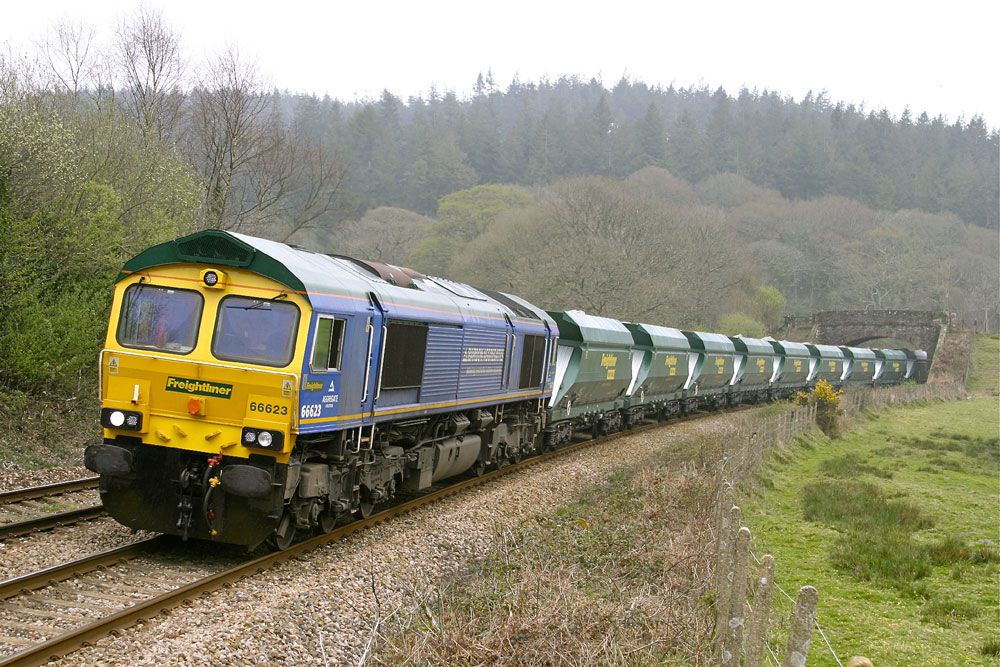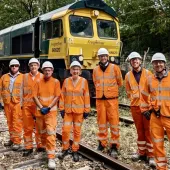Aggregates to market – a wider role for rail

First published in the April 2018 issue of Quarry Management
BDS Marketing examine the role of rail in the interlinked issues of aggregate sourcing, aggregate transportation and economic development
There is a significant mismatch in Great Britain between where the major sources of primary aggregates lie, and the geographical focus of economic development. This is a given that has to be managed carefully to ensure an adequate supply of aggregates is maintained and then effectively transported to market.
On 5 March 2018, the Government published its draft text for consultation for its National Planning Policy Framework (NPPF). In the last of the 17 sections in the document, mention was given to the ‘supply of minerals to provide the infrastructure, buildings, energy and goods that the country needs’. It was explained that planning authorities should ‘plan for a steady and adequate supply of aggregates’ and that policies should ‘safeguard existing, planned and potential sites for the bulk transport, handling and processing of minerals’.
This is a very small acknowledgement by the Government to the very big and interlinked issues of aggregates sourcing, aggregates transportation and economic development.
The chart below (fig. 1) helps to illustrate the situation across the regions of Great Britain (crushed rock is the predominant form of aggregate transported by rail, so sand and gravel has been excluded). Whilst some of the regions have a reasonably balanced picture of supply and demand, there are key areas that do not. The level of construction output in the South East accounted for almost 35% of the GB total in 2017, as reported by the Office for National Statistics, yet almost 100% of its crushed rock is imported. The South West and East Midlands supplied almost 55% of the total crushed rock in GB in 2017 but accounted for less than 15% of construction output. The role of Scotland is likely to take on greater import in future years as an exporter of crushed rock, as it holds nearly 25% of the total crushed rock reserves in GB (BDS 2016 estimates).
The use of rail to transport aggregates has increased in recent years, according to the Office of Rail and Road (ORR). A decade ago, rail-transported construction materials (including aggregates and cement) totalled 2.70 billion net tonne kilometres (tkm). This increased to 4.34 tkm by the end of 2017, with the last four years accounting for 70% of the increase. The ORR figures show that construction materials accounted for one in every four tkm of freight in their most recent figures for the fourth quarter of 2017.
The pressure on the Government to reduce carbon emissions is becoming a key driver in moving aggregates transportation from road to rail. Reductions of 57% in total emissions in GB by 2032 were made in the Fifth Carbon Budget, published in 2016. As HGVs are responsible for around 17% of total carbon emissions, the drivers for moving more aggregates transportation off the road network are clear.
In February this year, Network Rail published its Freight & National Passenger Operators Route Strategic Plan. It highlighted that it had budgeted for growth in construction freight of 1% per annum from 2012, but the reality was growth of 3.5%. This put further pressure on the same rail infrastructure used by passenger traffic, which itself has seen growth above that budgeted for.
To help the movement of aggregates, Network Rail has identified specific measures to pinpoint potential sites to facilitate connections to the rail network. These include new connections, bringing out-of-use infrastructure back into use and increased use of lineside loading. There are also likely to be sites in the right location and of the right scale in Network Rail’s own freight estate that could be utilized.
However, there is the threat of the removal and/or relocation of some existing rail freight facilities as a direct result of HS2 routing plans. Already identified among these, for example, are facilities at Toton, Leeds Freightliner Terminal, Leeds Midland Road and Leeds Stourton Aggregates.
BDS are aware of around 10 aggregates rail depots that have started operation in the last couple of years, all operated by leading national and regional aggregates producers. Several new deals have been announced recently between quarry operators and rail freight companies to increase the size and frequency of trains carrying aggregates across the country (much of this was reported in the BDS report ‘Estimated outputs of aggregates moved through rail depots’, published in 2017). In addition, BDS have identified, through their online planning monitoring service, four planning applications submitted in the last year for new rail aggregates facilities. These schemes, if consented, would increase the aggregates handling capacity on the network by nearly 1 million tonnes.
This is all welcome news that will help the Government move towards its targets for house building and infrastructure, but it is despite government policy and planning rather than because of it. Three days after the publication of the NPPF document, the London Assembly was set to discuss the Mayor’s Transport Strategy for London. This is a 322-page document focusing on developing a better transport delivery solution for the capital. With an ambition to ‘get more of London’s freight closer to its final destination by rail’, there is not one use of the word ‘aggregates’ in the entire report. Given that the South East and London is the single largest importer of aggregates to meet its construction needs, this comes as a disappointment.
This note scratches the surface of a very complex issue which is being attacked by the aggregates industry, Network Rail and the rail freight operators. Some targeted support at government level would significantly help these parties.
One proposal would be a government-led national aggregates task force, mandated to effectively marry up the interests of each party, including: government aspirations for economic growth; the provision of a sufficient long-term supply of primary aggregates; and a rail freight network with sufficient links and capacity
In other aggregates transport related news, a three-month consultation on the Safeguarded Wharves Review, last published in 2013, will be completed this year. This should be welcomed as forward thinking and recognition of wider issues in the broader ‘aggregates to market’ discussion.








